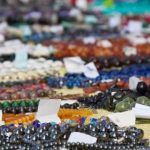Introduction
Drilling semi-precious stones is a creative and rewarding way to transform your favorite gems into beautiful pieces of jewelry. When done properly, drilling semi-precious stones can provide a unique look that transcends the traditional jewelry making techniques. In addition to aesthetic benefits, drilling semi-precious stones can also be used to enhance the structure of handmade earrings, pendants and bracelets. Whether you’re looking to craft statement theme pieces or simply add an interesting cast to well-worn ideas, learning how to drill semi-precious stones will open up a world of possibilities for your jewelry making business.
When working with semi-precious stones for jewelry making it is imperative that you take every precaution in order to avoid any potential damage or breakage as mistakes could potentially cost you dearly. Choosing the proper tools and materials is key when drilling semi-precious stones; professional quality diamond bits are highly recommended due to their hardness and strength being superior to other materials. Using low speed on your hand drill plugged into a dimmable power supply would also be preferred in order maintain proper control over the motion and circulation of the bit’s contact point with the stone surface. It might be beneficial your precision by adding depth guides cut from thin scrap wood which help guide the bit into its desired position without damaging the decorative finish and overall integrity of your precious stone beads.
Supplies Needed for Drilling Semi-Precious Stones
For drilling semi-precious stones for jewelry making, you will need the following supplies:
• Drill bit – This can be an ordinary diamond or carbide tipped drill bit. You may also want to look into bits designed specifically for drilling softer materials such as turquoise, opal, and petrified wood.
• Oil or Wax-Based Drilling Lubricant – A lubricant is necessary when drilling semi-precious stones in order to help cool the drill bit and prevent it from overheating, which could otherwise cause the material being drilled to fracture or chip. Avoid using water as a lubricant.
• Marble (or Ceramic) Tile – It’s important to use either a marble tile or ceramic tile surface while drilling your stones in order to make sure that they remain level and consistent as you work on them. This tile should also be larger than the gemstone itself.
• Safety Glasses & Mask – Protective eyewear is a must when working with power tools and smaller jewelry making objects like semi-precious stones, due to the potential for flying particles and dust. A dust mask is also recommended in order to protect your respiratory System from any airborne silica dust during drilling.
• Drill Press (Optional) – A handheld cordless drill can be used for most jewelry making tasks but when it comes to drilling items such as semi-precious stones, sometimes having a drill press makes things much easier as you can work on several pieces at once while keeping everything in alignment more easily.
Preparing Your Stones for Drilling
Before attempting to drill semi-precious stones for jewelry making, you should learn the basics of how to prep stones properly. The first step is to use a high powered diamond-tipped drill bit that can withstand the hardness of semi-precious stones. It’s also wise to buy a drill press that will give you even more control over the drilling process. With these two items, you can begin prepping your semi-precious stones.
For most gemstones, it is essential that you mark the center of each stone with a permanent marker before drilling into them. This will help to ensure an even and accurate cut so that your jewelry is well made. Additionally, you should select the correct type of stabilizer for the specific type of stone and secure it in place prior to drilling for extra stability during the drilling process. Finally, use a lubricant such as water or oil to keep friction from heat building up while drilling by creating buffer between moving parts of your equipment and the stone surface. By following these steps you’ll be sure that your semi-precious stone jewelry pieces look great after being drilled!
Acquainting Yourself with Different Drilling Techniques
Before drilling semi-precious stones for beading and jewelry making projects, it is important to become familiar with the various techniques used for drilling. There are three main methods that you can use to drill semi-precious stones: a regular power drill, a hammer and chisel, and diamond drilling.
1. A regular power drill is one of the easiest ways to drill through semi-precious stones, as it requires no previous knowledge or skill with stone carving tools. To begin, make sure that your power drill has the correct size and type of bit for your project. When using a power drill, always start at a slow speed and gradually increase it until the desired depth has been reached. It may also help to apply gentle pressure while being sure to keep the stone securely in place at all times. Additionally, be sure not to forget safety goggles while working as there will likely be dust generated from the drilling process.
2. Another common technique used for drilling semi-precious stones involves using a hammer and chisel set designed specifically for lapidary work. This method requires more skill than an electric drill as the operator needs to create evenly spaced holes with specific depths depending on their design requirements. Start by drawing out where you want each hole with either charcoal or a marker then carefully chip away at the designated area using steady, even blows from your hammer until you have reached your desired depth.
3. Lastly, diamond drilling is likely the most involved amongst all of these methods due to its delicate nature and intricate process requirements; it is often suitable only for experienced lapidaries who possess some degree of skill in fine jewelry making techniques and procedures. Diamond drills require immense patience as they tend to go through stone very slowly — not just in terms of physical speed but also due to how intricate each carve must be made depending on what kind of shape you need the drilled piece of gemstone/semi-precious stone/jewelry material to possess afterwards (rounded edges? sharp edges? faceted edges?). The principle remains largely similar across all three methods though; hence being consistent pressure whilst ensuring secure stabilization via suitable clamping mechanisms like rubber bands/vice etc..
Starting to Drill
Before starting to drill semi-precious stones for jewelry making, there are certain tips and techniques one should keep in mind. First, it is important to determine the type of stone to be drilled, as some stones require special drilling methods due to their density or other characteristics. Second, one should use a diamond core bit for drilling these stones as it is designed for hard-tipped materials such as agate, quartz crystal and diamond. Other bits may not be successful in these applications.
One should also make sure to wear safety glasses and work gloves when drilling the semi-precious stones in order to protect their eyes and hands from potential harm or debris that could splinter off of the stone during the process. Additionally, proper drilling speed is important; it should be slow enough so that over-heating does not occur but fast enough so that the job can be completed timely. Lastly, drills bits tend to slip on some smooth types of surface during certain applications; therefore one can cut a shallow circular groove at the area they wish to drill in order to help reduce slipping caused by heat buildup and pressure. This will help ensure a more precise hole which will result in overall superior jewelry results.
Measuring & Marking
Measuring and marking the area of the stone you want to drill is a critical step. Use calipers or other measuring tools to accurately measure the size of your stone and mark it with a pencil, pen or marker. This ensures that you will drill a perfect hole for the jewelry making project you are working on. Additionally, when using power tools such as an electric drill press, be sure to set the depth stop so that you don’t over-drill the stone and ruin it.
When drilling semi-precious stones for jewelry making, safety is always paramount! Protect your eyes, ears and limbs by wearing eye protection and proper clothing as well as ear plugs. Make sure that you have clamps in place to secure your pieces so they can’t slip while drilling which could cause serious injury or worse. Finally, use slow speeds until you feel confident in your ability to correctly handle the tool at higher speeds. This will ensure all edges are nice and smooth after drilling!
Best Practices for Drilling Semi-Precious Stones
When drilling semi-precious stones for jewelry making, it is important to take extra measures to ensure a successful outcome. For starters, it is essential to secure the stone in a vise or similar clamping device. This will ensure that the stone remains stable during the drilling process and prevents any damage from occurring due to natural movement of the object or slipping. Additionally, be sure that the spinning bit of the drill is correctly aligned with the design you are looking for when creating the hole in your stone. Make sure to provide adequate room around the intended hole by first pre-drilling with a smaller size bit and then slowly increasing dimension until your desired diameter has been reached.
It is also a good practice to use successively finer bits after drilling up to your final desired size in order to achieve a smooth finish. This can be done by starting with say a 60 grit sanding bit and working up through finer grits such as 120 and 240 respectively until you have achieved your desired result. For best performance, always use coolant oil when drilling semi-precious stones; this ensures that temperature buildup while operation is minimized and risk of heat shattering your piece is greatly reduced. Lastly, if possible make sure surface area of stone that will surround hole is flat so as to ensure optimal joint integrity when setting into jewelry design once completed.
Finishing Touches
Once you have successfully drilled the semi-precious stones for your jewelry making, it is time to finish up and give your designs the final touches. Depending on what kind of jewelry piece you are creating, there are a few different approaches you can take. If you plan on using threading, such as with beading or stringing projects, you can use your choice of beading wire, leather or other cord to attach each piece together in an organized pattern or design. You may also opt for wire wrapping around the edges of larger stones if you want to add more flair and intricate detailing to your jewelry. If soldering is more your style, you can use a torch and silver solder specifically designed for semi-precious metals. A bit of flux should be brushed onto each joint prior to soldering in order to keep the solder smooth as it cools down after heating.
Finally, once all of your pieces are soldered together, they will need a good cleaning to prepare them for polishing. The aim here is to remove any residue left over from a torch’s flame so that it doesn’t interfere with the stones’ natural shine when polished. Rubbing alcohol works quite well and should be lightly brushed over each piece before storing them away until they are ready for display. After this step is complete, all that is left is finishing off your designs with patinas or other methods such as oxidation or tumbling for added texture and lengthier lasting protection against tarnish buildup on metal surfaces!
Conclusion
Congratulations! You now know how to drill semi-precious stones for jewelry making. Now that you have acquired the right type of tools, materials and techniques, you can confidently choose appropriate stones and create beautiful pieces. Getting a clean, even drill hole can be especially challenging depending on the type of stone material you have chosen, but with patience and practice you will soon be able to go from novice to pro.
To build your skill further, consider researching the different categories of semi-precious stones available, as well taking part in an online or in-person workshop where experienced teachers can provide personalized guidance. Reading up on topics like setting and mounting jewelry pieces is also a great way for enhancing your knowledge and honing your craftsmanship. Happy drilling!

Welcome to my jewelry blog! My name is Sarah and I am the owner of this blog.
I love making jewelry and sharing my creations with others.
So whether you’re someone who loves wearing jewelry yourself or simply enjoys learning about it, be sure to check out my blog for insightful posts on everything related to this exciting topic!





